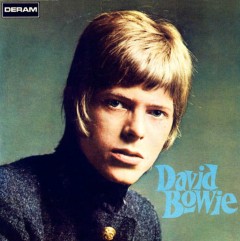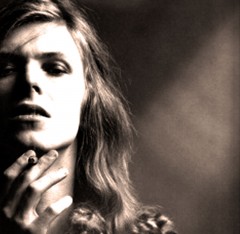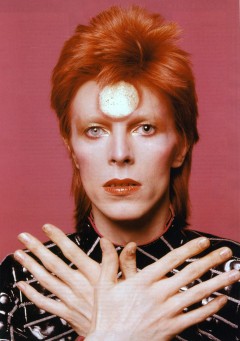Yesterday And Today
David Bowie–Musings from Outside the Circle: The Singer-Songwriter Years, 1967-1973
It has already been a year of passages. 2016 has begun with a reminder of all things temporal. It is a time for changes as the psalmist once said.
For the iconic rock artist David Bowie and those who traveled along on his musical ride over the last 49 years, the passage along his stardust trail of art outside the conventional gravitational forces came to a sudden and abrupt end as he succumbed all too mortally to a courageous 18-month battle with liver cancer. But, we don’t let go of our cultural icons easily. So the accolades and remembrances have steadily come in from all walks of life, from all generations, and across musical genres.
This last week has been one of personal reflection on the impact that one artist, who by and large traveled outside of my own chosen musical genres, has had on me. Much has been written and documented by fans and critics alike on the important breadth of a career that transversed the cultural space between style and substance with pop hits that kept artistic integrity and brought accessibility to avant-garde expression
David Bowie was an iconic musical innovator, a stylist and a trendsetter, a visionary rock poet and performance artists extraordinaire. In the end, these are all descriptions that David Jones (aka David Bowie), would have called “rubbish.” Unlike many artists who take on personas in performance, Bowie was not hollow at the center. At the core of the decades of the inventive work that constantly pushed at social and artistic comfort zones was a solid identity, an author in control of his creation.
Beneath the multiple layers of creation there was a singer-songwriter who developed his melodic and lyrical craft in ways that often stunned and astounded peers and fans alike. Without his years (1967 through 1973) of intense focus on songwriting interwoven with performance and storytelling through character and narrator, the successful years that followed would not have been possible. Like a genius abstract artist who is fully capable of painting classically, Bowie had all of the linear talent to create a legacy of early albums with songs that took the pop songwriting language of the ’60s, twisted and turned them to his own devices and his own themes that often didn’t conform to the rock ethos of the latter part of the decade. His story was for a future time. It’s a time the rest of the world is still trying to catch up with.
When Bowie began in the pre-Beatles rock music world of 1962, the songwriting possibilities were endless. By 1967, with the debut of his self-titled solo album, he had begun writing lyrics from a character’s perspective–drawing from the musical influence of the English music halls, vaudeville, and such unlikely inspirations as Anthony Newly. His first album is a wonderful mish-mash of vaudevillian lullabies with bouncy childlike melodies and catchy lyrical refrains throughout. Songs like “Uncle Arthur,” “Maid of Bond Street,” and “Join the Gang” play like the Kinks meet Gilbert and Sullivan through a psychedelic lens. Although the album proved to be commercially unsuccessful and bore little resemblance to who Bowie would become over the next 40 years, it is today considered a distinctive and original work worthy of reconsideration as part of Bowie’s songwriting legacy.
His second solo album, Space Oddity, released in 1969, found Bowie fully immersed in British folk-rock with blues strains familiar to the English rock of the day. But, this was not Donovan or even Fairport Convention. This was the bare beginnings of the embryo of the character who became Ziggy Stardust, peering around the corner on the classic title song and on the beautifully harmonic rock landscape of “Wild Eyed Boy From Freecloud” and “Memory of a Free Festival.” Gone was the vaudevillian mock conceit of his debut album, replaced with a self-assured, futuristic sound that had no place in the rock world of 1969–when all things from England were either pure psychedelia or blues based. It was notably the appearance of Major Tom on the 2001: A Space Odyssey-inspired title song that would bring the album back into view on international charts during the landmark year of Ziggy Stardust: 1972.
The thread that held his work together as a young artist was the strength of narrative, which shows the influence of The Who and Peter Townsend’s fondness for creating fiction in song. Showing up in full regalia is the influence of Bob Dylan on the lyrical rock and rage of “Unwashed and Somewhat Slightly Dazed.” The album also included the first appearance of legendary lead guitarist, Mick Ronson, who would later become a Spider from Mars.
The most distinctive song on the Space Oddity album showing his leap toward the future is “Cygnet Committee,” a narrative from the perspective of a betrayed messiah. It echoed the familiar ring of the yet-to-be released Who masterpiece, Tommy.
Bowie was jumping the gun on Townshend’s rock opera minus the narrative structure and story cohesion. But, then, Bowie, as a writer and an artist, was never about structure or cohesion. His work was always visceral and authentic without ego calculation or manipulation. It was the by-now established rock conventions and ego-driven nature of the business that Bowie was intent on blowing up. And he did.
The anarchistic nature of Bowie, in 1969, demonstrates his forerunner status as godfather of the punk movement of London in the mid-’70s. So it was no surprise when he eschewed the folk-hippie strains that were found on Space Oddity in favor of a pure electric hard-rock core.
On his third album, 1971’s The Man Who Sold the Earth, Mick Ronson, producer and bassist Tony Visconti, and Bowie created a rock record that feels like it could make the stars fall from the sky. If this was the first audition test flight for the Spiders from Mars they passed beyond all expectations.
The themes and music on this epic album was darker than the previous two Bowie albums. If anything, here are the first clear rumblings of the story that became Ziggy Stardust and the Spiders from Mars.
Opening with the musically, lyrically, and thematically sprawling “The Width of a Circle,” Bowie goes straight (ironic pun intended) into a dizzying bisexual encounter that finds him in the depths of hell and begging for more. This was uncharted territory in 1970 rock music. There was plenty of talk about hell but never involving a same-sex sexual encounter.
Bowie’s song and the album succeed with passion, energy, and rock ‘n’ roll majesty. Today the album is considered a forerunner of punk and modern metal music.
There are times when the hard work of pushing out the conventions of established art pays off. The year, 1971, allowed Bowie to pick up the pieces of the rock conventions he had blown apart and assemble his own unique world from the rubble. This was the year of Hunky Dory.
A forerunner to his break-out classic and conventionally regarded as his finest album, Hunky Dory is a loose collection centered on Bowie’s work as a singer-songwriter. It is by far his most conventional album musically, however, most of the themes he would build on over the decades that followed are found on this collection. It’s as though the Bowie/Ziggy, artful dodger outsider is peering in at us from the outside, but rather than asking to be let into the rooms of comfort and convention, he’s gently inviting us to come out and play. This is the magic of Hunky Dory with themes of sexual ambiguity, insanity, Nietzsche-inspired declarations, and abstract musings that nevertheless manage to touch earth–Bowie had effortlessly fashioned one of the best albums of the day. Opening with the autobiographical classic “Changes,” he moves into songs of alienation (“Life on Mars”) and pays tribute to his musical and artistic influences, (“Song for Robert Zimmerman” “Andy Warhol”).
Among the consistent song-gems on Hunky Dory is Bowie’s nod to his first album with the uplifting “Fill Your Heart,” which is one of the few times you can almost hear his smile singing out from the record. If there is any album in Bowie’s canon that would point to his mastery as a singer-songwriter, it is Hunky Dory.
On Bowie’s fifth album and final work of what I would term his singer-songwriter period, he achieved that rare musical feat of creating one of the best, most assured records of the rock era. The Rise and Fall of Ziggy Stardust and the Spiders from Mars is the accumulation of his past work and a vision of what is in store in the future for the songwriter turned fully and surreally baptized performance artist. Ziggy Stardust is a creation of a rock myth come to full three-dimensional life in sound and story. The album is a cinematic tale of a rock start with a touches of cabaret, power-pop, sci-fi noir, and punk visions that have not yet been born, but hinted at on this masterpiece .
If Hunky Dory was Bowie’s singer-songwriter peak, then Ziggy is the realization of the author of the myth fully disguised behind every power cord and celestial lyric. It is David Bowie’s Sun Records moment, his Blonde on Blonde and Sgt Pepper. It is the album that opened the doorway for Bowie to walk into the unpopulated room of rock immortality.
However, ironically, it was also the beginning of Ziggy Stardust’s long farewell, because, just as in the story of Ziggy’s ultimate destruction by his fans, and just as Bowie himself blew out rock conventions through challenging themes and musical structures, his realization of Ziggy Stardust on record and over the course of a two-year tour, was also his farewell to his created myth, his shedding of the skin of rock myth to allow him to take on a new persona and new musical landscapes. On the final song of the album, “Rock ‘n’ Roll Suicide,” Ziggy sits in an imaginary backstage and lets his mind wander to his own destruction. And he finally sings like a rock ‘n’ roll preacher, “Oh, no love, you’re not alone… you’re wonderful.” And he was–Ziggy and David–now one in the boundless dream of the imagination.
David Bowie’s years of development as a lyric-driven singer-songwriter came to an end with the final 1973 tour of Ziggy Stardust. But, as a pop artist and rock star, in 1973, David Bowie had only begun. He changed and transformed through much of future work, including the brilliant soul excursion of Young Americans and the pop breakthrough of the ’80s Let’s Dance, which was the foundation he formed from 1967 to 1973 in those songs that drove him. He was no longer confined not only to songwriting, but he also began to influence the entire musical landscape. Today his influence seems to be everywhere in popular music. This has been evident as pop stars, rap artists, country singers, soul artists, and jazz musicians have talked about his influence on them.
Bowie always wrote with passion and imagination, but such inventive lyrical work was a formative and important time for one of the world’s most important artists. Over the years, as he ventured into acting, especially in the classic Nicholas Roeg film, The Man Who Fell to Earth, and his 1980 stage appearance in The Elephant Man, it became clear that this was an artist whose gifts exceeded one form or any musical genre.
What it takes to be an artist as brilliant as David Bowie is clearly seen in his willingness to lay himself open to his art and to connect with his audience. This is what has separated him from the obtuse and esoteric, which never really touch flesh in any art form. David Bowie always touched us and moved us. The core of this can be found in its most concrete form on the five albums released between 1967 and 1973.










